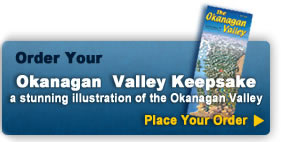WEST KELOWNA & Peachland History
WEST KELOWNA:(formerly known as Westbank) is an orcharding community which has grown since the Fur Brigade Trail’s establishment in 1811.The area was used by fur traders working for the Hudson’s Bay Company.Since then the area has blossomed into Westbank, with the surrounding communities of Shannon Lake, Gellatly Flat, Lakeview Heights, Powers Creek, Rose Valley, Glenrosa, Casa Loma and Bear Creek all contributing to the history of the area.
West Kelowna went through many names changes in its history.Originally called MacDonald’s Plain from 1811 to 1848.This name was abandoned along with the Fur Brigade Trail. Five other names were given to the area such as Sunnyside (1872 to 1881), Westside (1901), Hall’s Landing (1901), Westbank (1902 to 2007) which the post office in Shannon Lake was named and Westbank continued to grow into the bustling and vibrant area it is today.In 2007, Westbank’s name was changed again to West Kelowna.
With historic sites such as Gorman’s Lumber and Box Company, Gellatly Heritage Park and the Gellatly Nut Farm, along with many others, Westbank offers the community a rich heritage and identity which is best discovered by visiting these sites.
PEACHLAND: From 1812 until the Canada-US Border was determined in 1846, the Fur Brigade Trail was a lively route of commerce from South to North, up the Okananga Valley to Fort Kamloops. As the Trail wound Northwards from Shingle Creek to Garnet Valley and over the mountains to Deep Creek, it touched down to lake level at the spot that is now Peachland. Back then, as now, travellers welcomed a swim in the crystal clear, pebble bottomed lake and many campfires dotted the shoreline over the years.
PEACHLAND: From 1812 until the Canada-US Border was determined in 1846, the Fur Brigade Trail was a lively route of commerce from South to North, up the Okananga Valley to Fort Kamloops. As the Trail wound Northwards from Shingle Creek to Garnet Valley and over the mountains to Deep Creek, it touched down to lake level at the spot that is now Peachland. Back then, as now, travellers welcomed a swim in the crystal clear, pebble bottomed lake and many campfires dotted the shoreline over the years.
The area known as Peachland was first settled by the Lamblybrothers who owned all the land from the base of Drought Hill to the South of Lilly Street. In 1898, J.M. Robinson, a developer from Manitoba and one of the owners of the Canadian American Gold Mining and Development Company established a townsite and named it Peachalnd because of the delicious fruit grown by Harry Hardy on the Lambly Ranch. There was little gold found, but the pioneer families who moved from all over the world to homestead in the newly established town knew they had come to a very special place. Historic Peachland has a most unusual museum housed in an eight-sided former Baptist church built in 1910. within its walls, hundreds of artifacts, exhibits and photographs tell the story of Peachland through its people. Peachland pioneers were an intrepid, hard working lot, but they also knew how to have fun! In the Museum, the minute book of the Bachelor`s Club of 1911 chronicles a dance held on February 22nd of that year attended by 200 brave souls who came all the way from Westbank, Summerland and Kelowna to eat, dance and socialize in the middle of winter.
The Central Okanagan Railway Company has constructed and maintains a model railway based on the Kettle Valley Railway and its operations in the Okanagan complete with Lake Tug and Barge Service,We are open most afternoons. Stop by and visit - Everyone Welcome!



